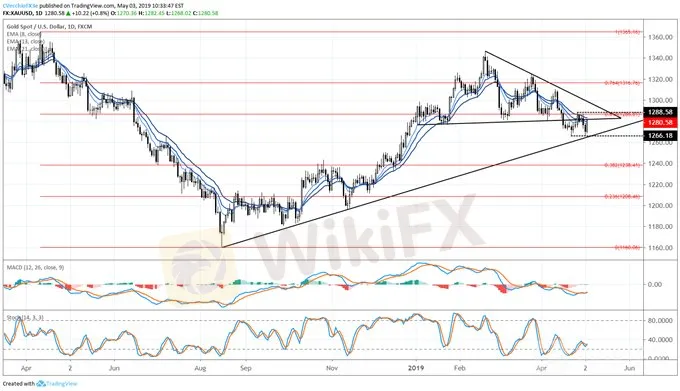简体中文
繁體中文
English
Pусский
日本語
ภาษาไทย
Tiếng Việt
Bahasa Indonesia
Español
हिन्दी
Filippiiniläinen
Français
Deutsch
Português
Türkçe
한국어
العربية
Gold Prices Coil within Two-Week Range after US NFP Letdown
Abstract:The past few days have produced choppy price action in Gold and the US Dollar, but price action after the May Fed meeting may point to near-term resolution.
Gold prices have had a rocky week, between the May Fed meeting and the April US Nonfarm Payrolls report. Fed Chair Jerome Powell came across as more optimistic than people anticipated regarding price pressures, initially sending the US Dollar higher and Gold lower on Wednesday.
Calling low inflation “transitory,” Fed Chair Powell seemingly sidestepped committing to more easing. After all, he has said that the FOMC would consider a policy adjustment if inflation were to be low on a “persistent” basis.
In turn, as the US Dollar and US Treasury yields ran higher on Wednesday and Thursday, Gold prices were knocked lower.
But that momentum was halted today when a superficially strong US jobs report didnt serve as the solidifying factor for sentiment that traders were looking for. Even though the topline figure topped 200K and the unemployment rate fell to a new cycle low, wage growth missed expectations and the labor force participation rate dropped unexpectedly.
Between the May Fed meeting and the April US Nonfarm Payrolls report, prices across asset classes have carved out a range as no clear sentiment has emerged after this week's events.
Gold Price Technical Analysis: Daily Chart (April 2018 to May 2019) (Chart 1)

Since setting a fresh yearly low on April 16, gold prices have been moving sideways around former symmetrical triangle support. But as the uptrend from the August, October, and November 2018 lows has come into focus, gold prices have been stuck trading between 1266 and 1288. This coiling effort has shifted attention away from the multi-month symmetrical triangle to the two-week sideways consolidation.
Accordingly, the gold price forecast is necessarily neutral heading into next week: a move below 1266 by mid-May would constitute a downside break of the consolidation as well as the uptrend from the late-2018 swing lows; while a move above 1288 by mid-May would constitute a topside break of the consolidation as well as the downtrend from the February and March 2019 highs.
IG Client Sentiment Index: Spot Gold Price Forecast (May 3, 2019) (Chart 2)

Spot gold: Retail trader data shows 75.9% of traders are net-long with the ratio of traders long to short at 3.15 to 1. The number of traders net-long is 0.2% lower than yesterday and 3.3% lower from last week, while the number of traders net-short is 7.2% lower than yesterday and 4.1% lower from last week.
We typically take a contrarian view to crowd sentiment, and the fact traders are net-long suggests spot gold prices may continue to fall. Traders are further net-long than yesterday and last week, and the combination of current sentiment and recent changes gives us a stronger spot gold-bearish contrarian trading bias.
Disclaimer:
The views in this article only represent the author's personal views, and do not constitute investment advice on this platform. This platform does not guarantee the accuracy, completeness and timeliness of the information in the article, and will not be liable for any loss caused by the use of or reliance on the information in the article.
Read more

KVB Market Analysis | 30 August: JPY Strengthens Against USD Amid Strong Q2 GDP and BoJ Rate Hike Speculation
The Japanese Yen (JPY) strengthened against the US Dollar (USD) on Thursday, boosted by stronger-than-expected Q2 GDP growth in Japan, raising hopes for a BoJ rate hike. Despite this, the USD/JPY pair found support from higher US Treasury yields, though gains may be capped by expectations of a Fed rate cut in September.

KVB Market Analysis | 28 August: Yen Strengthens on BoJ Rate Hike Hints; USD/JPY Faces Uncertainty
The Japanese Yen rose 0.7% against the US Dollar after BoJ Governor Kazuo Ueda hinted at potential rate hikes. This coincided with a recovery in Asian markets, aided by stronger Chinese stocks. With the July FOMC minutes already pointing to a September rate cut, the US Dollar might edge higher into the weekend.

KVB Market Analysis | 27 August: AUD/USD Holds Below Seven-Month High Amid Divergent Central Bank Policies
The Australian Dollar (AUD) traded sideways against the US Dollar (USD) on Tuesday, staying just below the seven-month high of 0.6798 reached on Monday. The downside for the AUD/USD pair is expected to be limited due to differing policy outlooks between the Reserve Bank of Australia (RBA) and the US Federal Reserve. The RBA Minutes indicated that a rate cut is unlikely soon, and Governor Michele Bullock affirmed the central bank's readiness to raise rates again if necessary to combat inflation.

KVB Market Analysis | 26 August: Bitcoin (BTC) Breaks Out Above $60,000, Faces Resistance at $72,000
Bitcoin traded above $60,000 on Friday, gaining over 4% this week but staying within a $57,000 to $62,000 range for the past 15 days. On-chain data reveals mixed signals, with institutions accumulating while some large holders are selling. Inflows into US spot Bitcoin ETFs and potential volatility from ongoing Mt.Gox fund movements could impact Bitcoin's price in the coming days.
WikiFX Broker
Latest News
AIMS Broker Review
The Hidden Checklist: Five Unconventional Steps to Vet Your Broker
Russia to Fully Ban Crypto Mining in 10 Regions Starting January 1, 2025
YAMARKETS' Jingle Bells Christmas Offer!
Why is there so much exposure against PrimeX Capital?
Two Californians Indicted for $22 Million Crypto and NFT Fraud
WikiFX Review: Is Ultima Markets Legit?
Colorado Duo Accused of $8M Investment Fraud Scheme
MTrading’s 2025 "Welcome Bonus" is Here
FCA's Warning to Brokers: Don't Ignore!
Currency Calculator



